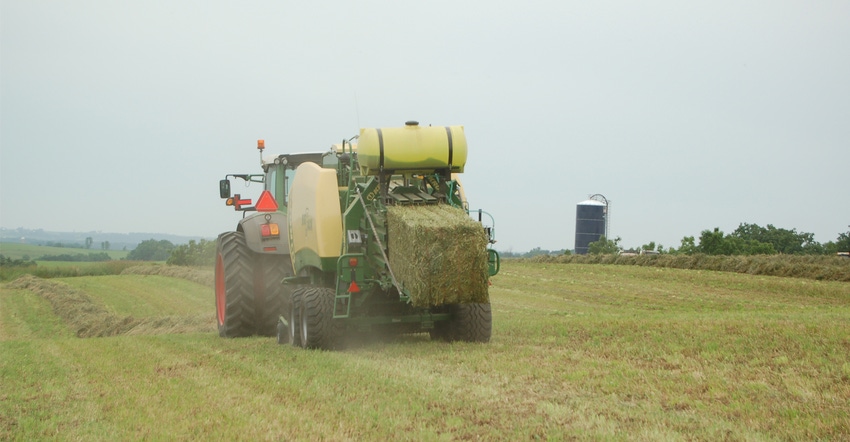June 1, 2020

Hay production in Iowa is declining, but demand from livestock producers remains constant. Hay prices have increased in recent years as fewer farmers are willing to grow their own hay and navigate the challenges that come with it.
Dale Leslein manages Dyersville Hay Auction in northeast Iowa, one of the largest hay auctions in the state. He sees semiloads of hay coming in from as far away as California, Canada, New York and anywhere in between. Farmers in Iowa would rather plant other crops as opposed to hay.
“The age of the farmer is probably the No. 1 reason,” Leslein says. “Farmers are getting older, and corn and soybeans are easier to raise than hay. Also, there are no government programs for hay producers like there are for row crop farmers. They get crop insurance and protection where hay producers don’t.”
Kevin Brown, president of the Eastern Iowa Hay Producers Association, agrees decreased hay production is likely because of aging farmers. Producing hay can be labor intensive, and more farmers would rather grow corn and soybeans instead. “It’s simply easier to plant a crop in the spring and harvest it in the fall with modern equipment, and not face the heat of summer,” Brown says. “Grain is also far easier to market and transport than hay.”
More management required
Another reason more Iowa farmers have stopped growing hay is because of the impacts weather can have on the forage crop. Over the past few years, many acres of alfalfa have drowned in flooding. “We’ve had several disastrous years for hay crops,” Leslein says. “The No. 1 thing needed for producing quality hay in Iowa is patience. You’ve got to watch the weather with a very close eye and manage the hay crop accordingly.”
When the crop is successful, hay in Iowa is primarily used for feeding livestock. Different grades of hay are used for different animals. The number associated with hay grades increases with the quality of the hay. “Grade 180 and above is supreme grade, 150 to 180 is premium, 120 to 150 is your good hay,” Leslein explains. “Poor-quality hay is rated under 100. There is also a utility grade, which is damaged hay. Utility-grade hay was rained on or became moldy.”
Premium hay is typically fed to dairy cattle. Brown says a lot of dairy and cow-calf producers still grow their own hay. This way they can be guaranteed supply and cost. “Dairy cows have the greatest nutritional needs,” he notes. “The best way to be sure of getting the highest-quality hay is to produce it yourself.”
Cattle in feedlots are fed hay of lower quality because they don’t require high levels of protein. Feedlot hay is part of a complete ration and serves as roughage for the ruminate digestive system. The hay yielding the highest prices and quality is marketed to horse owners. Many horse owners do not have the land or equipment to grow their own hay. Small, square bales for horses are also more difficult to produce, increasing the price further.
Hay demand strong
Demand for hay in Iowa is strong and is expected to continue strong, especially for higher-quality hay.
In addition to decreasing acreage, recent weather conditions haven’t been ideal for production. Leslein predicts a delay in the first crop harvest this year because of low temperatures and rainfall. “Farmers who feed hay are going to have to stretch out their hay supplies currently on hand. We’ll have to stretch those supplies into June,” he says. “I think this will create a lot of demand for hay when we get into July, especially if a dry weather pattern continues. We could be looking at an explosive summer market this year.”
At the weekly Dyersville hay auction on May 13, large square bales brought the following prices per ton in these hay quality categories:
premium, $200 to $255
good, $170 to $220
fair, $120 to $160
utility, $90 to $120
Large round bales brought the following prices per ton in these hay quality categories:
good, $100 to $135
fair, $65 to $95
utility, $10 to $65
These prices include pure alfalfa hay and alfalfa-grass mixed hay. For good-quality grass hay, large square bales brought $100 to $120 per ton, and large round bales brought $80 to $135.
Increase in hay stocks
All types of hay stored on Iowa farms as of May 1 this year was estimated at 510,000 tons, an increase of 48% from May 1, 2019, according to the latest USDA survey. Reflecting continued strong demand for hay, disappearance from Dec. 1, 2019, through May 1, 2020, totaled 1.67 million tons, only slightly below the 1.72 million tons for the same period a year earlier.
Hay stocks nationally have also increased from a year ago. All hay stored on U.S. farms as of May 1 totaled 20.4 million tons, up 37% from May 2019, which were the second lowest since records began in 1950. Disappearance from Dec. 1, 2019, to May 1, 2020, totaled 64.1 million tons, down less than 1% from the same period a year earlier.
Harvested hay acres in Iowa in 2019 totaled 1.02 million acres of all types. There were 700,000 acres of alfalfa and 320,000 acres of hay excluding alfalfa. That compares to 13 million acres of corn for grain and 9.1 million acres of soybeans.
Friedrichsen is a Wallaces Farmer intern.
You May Also Like




